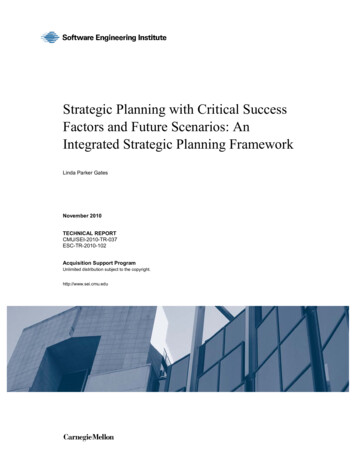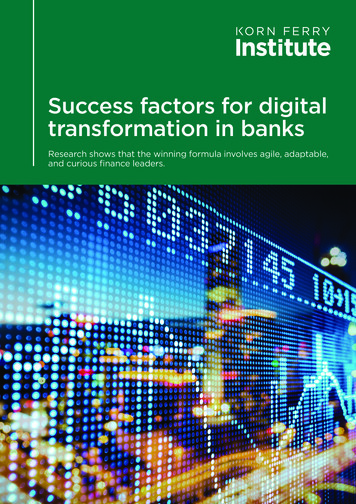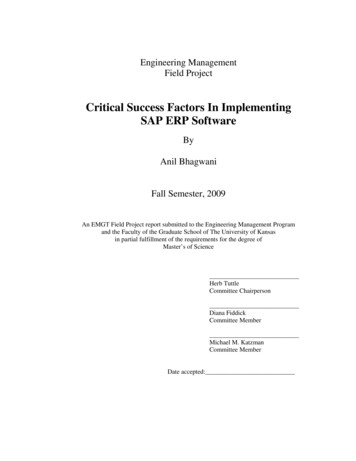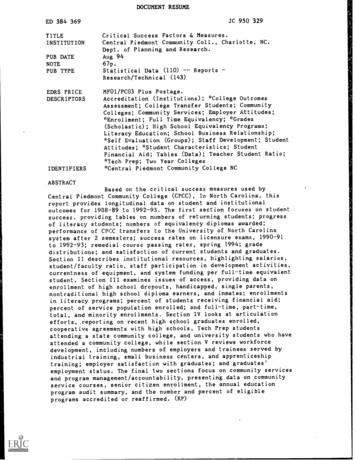
Transcription
Identify the Critical Success Factorsof CRM ImplementationA study on Chinese Commercial BankSIJIE WANGMaster of Science ThesisStockholm, Sweden 2011TRITA-ICT-EX-2011:172
Identify the Critical Success Factors of CRM ImplementationA study on Chinese Commercial BankMaster ThesisAuthor:Sijie WangSupervisor:Eriks SneidersMay, 2011This thesis corresponds to 20 weeks of full-time work for the author1
AbstractThe demand from the customer and pressure from the competitive market drive most ofthe Chinese commercial banks either on their way to implement the CRM systems or theyare positively looking for the opportunity to integrate the CRM as an indispensable partof their business strategy in the next few years to come.Customer Relationship Management originated and prevailed among western companies,it has already spread in many East Asian countries, such as: Japan, Korean and China. Inorder to improve the existing CRM implementation process and enhance the success rateof the CRM implementation, we present the most important Critical Successful Factorsfor the CRM implementation through literature reviews, the chosen CSFs were based onprevious studies in the CRM implementation field, focus on the identification of CRMprojects, whether they have achieved success or subject to obscure deficiency.Subsequently, the literature study will provide us a group of CSFs which considered to bea comprehensive summarization of those most important factors for CRMimplementation projects in western financial institutions.In order to better understand the current situation in China, we conduct two in-depthinterviews with the experts in relevant domains, the questions of the interviews weredesigned to assess the CRM implementation in Chinese commercial banks, the problemsand challenges, the feasibility of those CSFs in Chinese unique culture, and the practicalexperiences in implementing the CRM will be discussed.The result of the interviews supported the feasibility of those CSFs in implementingCRM in general, however, the CSFs and their importance in implementing CRM inChina are varied due to the cultural issues and industry differences. This requiresadaptable changes to be made to the CSFs group in order to use it more effectively underthe Chinese environment.This thesis is addressing the subject of implementing CRM in China. As for this subject,it lacks sufficient theoretical and empirical researches, in addition, We conclude ourresearch with dedicate effort by analyzing the empirical data from the interviews andproposed a guideline to emphasize the importance of the CSFs for the CRMimplementation in Chinese banks and also increase the knowledge about the currentCRM in Chinese commercial Banks, thus can help to increase the CRM implementationsuccess rates in future.2
AcknowledgementsMy sincere appreciation to my supervisor, Dr. Eriks Sneiders for guiding me till the endof this research .The completion of this thesis would not be possible without the help and support of him.His professionalism and prudent working attitude have made me a model to follow.My deepest thanks to my family, for their unreciprocated love .My truly appreciation for the two experts who do not want their names to be revealed foraccept my interview invitations.3
Table of ContentsChapter 1. Introduction .61.1Background .61.2Problem area discussion . 71.3Research goal . 81.4Research questions and expected results. 91.5Limitations . 101.6Outline of the thesis. 10Chapter 2 Research Methodology.122.1Introduction . 122.2Proposed research approach . 122.3Interview as a data collection technique . 142.4Data analysis . 152.5Originality and reliability . 162.5.1Originality . 162.5.2Reliability. 17Chapter 3. Literature review .183.1Why we need CRM ? . 183.2CRM in Chinese banking sectors . 193.2.1Background . 193.2.2eCRM and web service . 193.2.3CRM and China Social Credit System. 203.2.4Supporting network and architecture development . 213.3Problems remains to be solved for the CRM in Chinese commercial bank. 213.3.1Management culture. 213.3.2Rigid mechanism . 213.3.3Credit system . 223.3.4Risk management skill. 223.4The gap between CRM in Chinese banking and western banking. 224
3.4.1Gap in business process perspective . 233.4.2Gap in differentiated customer marketing . 243.5Exploring CRM implementation failures. 243.6CRM success factors . 25Chapter 4. Interview design .294.1Selection of the interview participant. 294.2Design of the interview questions . 30Chapter 5. Interview result.325.1First interview with Bank AB’s IT manager X . 325.2Second interview with the IT consultant Y. 33Chapter 6. Analysis of the interview result .366.1CSFs for CRM in Chinese banking. 366.2Improve the CRM success according to the CSFs . 37Chapter 7 Conclusions .397.1What are the reasons lead to the failure of the CRM in banking sectors ? . 397.2What are the suitable CSFs for Chinese banking sectors? . 407.3How to reach the CRM success in Chinese banks? . 417.4Contribution of this study. 427.4.1Theoretical contributions . 437.4.2Practical contributions . 43Appendix .44Graph 1: Research Process. 44Graph 2:Practical CSFs hierarchy for CRM success . 45References.465
Chapter 1. Introduction1.1BackgroundSince the year of 2001, China has entered the World Trade Organization(WTO)forover 10 years, the granted WTO membership for China signal the continued forwardmovement of the economic globalization process, and China has become an importantmember of the world economy (Morrison,2001). Customer Relationship Management(CRM), is a management tool which focus on maintaining and developing customerrelationships (Buttle, 2004) have become a major concern for many businessorganisations across the globe.There is no doubt that CRM as a management strategy and concept was originated inwestern countries, but the CRM came on stage in banking industry were considered to bea result of ever increasing competition on high value customers. The investment in CRMhas helped the banks better monitoring the customer behaviors, understanding what theyhave done in the past, and predicting the customer’s future behaviour( Xu, et al., 2002).Since 1990s, when CRM first entered the Chinese market, it has achieved huge successand also experienced various problems during the last 20 years, Nowadays, the bankingsectors in China are facing huge pressures since the global competition have reached outto their business such as : loans, deposits, and the shrink of profit margins (SAPAG,2002). Besides, the bank itself also need internal organizational change activities andstrong support from the management team. Though the cost for CRM implementation ishigh, the trend of implementing CRM as an enterprise strategy is inevitable (Onut et al,2006). The banks and other service sectors have vigorously implemented CRM projects.However, the result of the CRM implementation were not always promising. Indeveloping countries, especially in China, the CRM has been advertised as a fashion salesstrategy, a remedy for all ills, or just another function module which can only be usedseparately. Such as the widely accessible call centres, data collection tools(Bhaduri,2005). However, implementation of such a system is not a panacea, and is not, of itself,sufficient to transform a production oriented organization into a customer-oriented one(Kanji, 2002; Chang, 2005), The utilization of technology equipment without properstrategy guideline will lead to the failure of CRM implementation. The philosophy ofCRM places the customer as the core during the organisation’s business process andactivities, a successful CRM implementation should “create and keep a customer” and to“view the entire business process as it consists of a tightly integrated effort to discover,create, and satisfy the request from the customer”.6
From academy to business practitioners, both sides have all put consistent efforts onfinding out the success factors from their own perspectives. Whilst, most of the studieshas been done on IT related factors(Injazz J. Chen & Karen Popovich, 2003), others aremore focused on organizational factors include: human factors, organizational structures,and rewarding mechanisms (Hugh Wilson, Elizabeth Daniel & Malcolm McDonald, 2002) .As management consultant Peter Drucker once said: “If you can’t measure it, you can’tmanage it.” So the banks in China has to conduct a scientific, comprehensive CRMsuccess investigation, not only to measure the actual, internal functions of the CRMproject but also those critical factors which can impact the final success of the CRMimplementation, a more carefully examination should be conducted and concrete factorsshould be identified, the core business process and behaviors (human factors) shall bemonitored and evaluated, in order to guarantee the successful realization of the strategicgoals set by the organizations. Only through such process, the organization as well as thewhole industry can learn and improve itself.1.2Problem area discussionThe CRM vendors has created spectacular images thrives on the booming expectationstowards CRM’s benefits for the organization. For those organizations who plan toimplement such systems as part of the business strategy. However, a huge number ofCRM projects fail, the efforts are proved to be in vain(Coltman, 2006). The currentsituation of CRM in Chinese commercial banks may encounter the identical obstacles asthe contemporary foreign banks in Europe once had, the rate for successfulimplementation of CRM in the Chinese commercial banks is below 30%, hardly justifythe investment on implementing the CRM systems(Gartner report,2009).As an indispensable part of global financial market, Chinese financial institutions havefaced similar dilemmas as his contemporaries in western countries once were, while theChinese traditional planned economic system were abandoned, the market economysystem are gradually accepted and prevailed, this emerging market has its owncharacteristics which has impacted the CRM systems in the following ways:1.The customer maintenance is still heavily rely on the important personnel contacts,which means the focus and retention of the “golden customer” are hard to accomplishespecially in Chinese culture.7
2.The business process reengineering (James Champy et al.,2007) which can be achievedthrough the implementation of CRM haven't been able to alter the concept of theemployees in the bank, which hinder the fully utilization of the CRM.The current situation is that the banks still can not provide tailored services for eachcustomers, specifically, the banks fail to retain its existing customers nor to gain newcustomers. The current CRM projects in Chinese banking sectors are merely an ITsystems that can only be used to store the customer’s profiles, the transaction histories,and preferences on purchasing the goods. Later on, the banks will utilize those data as areference to track the customer by sending emails, and do cold callings. In short, theCRM in Chinese banking sectors do not match with the management expectations.It is asserted from the literature that most of the financial companies in western countieshave already aggregated abundant experiences in conducting the CRM projects, thisnaturally requires a wide-ranging overhaul of organizational structures, effort onemployee training and rewarding system, as well as appropriate IT support (Chen &Popovich, 2003). Compared with the CRM implementation in western countries, Chinamight face the problems from both economy and technology, and other external aspects.The motivation of researchers and practitioners is to find out the reasons under the covers,and most importantly, identify the success factors in the project of CRM implementation,this approach is believed to be able to help the banks to minimize the project failurepercentage. Most researches have addressed the issue of enhancing the success rates ofCRM projects. (King and Burgess,2007, Mendoza et al, 2007, Payne and Frow, 2005).These studies were naturally under western culture environments. Nevertheless, suchresearch in China are insufficient, This thesis will address the above issues under theChinese characteristic market and focus on investigating the reasons lead to the failure ofCRM implementation and discuss how to guarantee a successful CRM implementationin a commercial bank.1.3Research goalGoal 1:To increase the understanding of CRM in Chinese banking industry.It is true that CRM is still an innovative approach in business management area and not tomention the role it plays in developing countries include China, through the literatureresearch and interviews with the two experts. We noticed that most banks in China aremore concern the component function of CRM on a technology basis. However, this isinsufficient, to achieve a successful delivery of a CRM project, the banks need tointegrate the hardware, software, and adapt to possible changes, those changes subject toculture differences. Last but not least, the employee training.8
Goal 2: To identify the Critical Success Factors affecting the implementation of CRMThe success and failure of the CRM projects subject to the factors which holdaccountable during the CRM implementation stages, processes, and components. Thisthesis will analysis the previous researches around the world, and try to summarize thosecritical success factors which have been mentioned the most.Goal 3:To justify and validate the summarized critical success factors (CSFs) through theempirical evidence and suggest how to best reach success according to these factorsTo understand the real circumstances in the Chinese banking sectors, we conductedinterviews with the industry experts to extract their professional knowledge, based on thesummarized CSFs, we can analyze both data from different resources and give outsuggestions on how to improve the CRM implementation in Chinese banks.In this research we will only identify the CSFs on how to improve the CRM success ratesin Chinese commercial banks. Since the measurement of those CSFs would require anextensive quantitative study so this will be considered to be an option for future study.1.4Research questions and expected resultsThe research questions are summarized as :1. What are the reasons lead to the failure of the CRM in banking sectors ?2. What are the CSFs for CRM systems in Chinese banking sectors?3. How to reach the CRM success in Chinese banks?For the question 1. Literature on CRM implementation in Chinese banking sectors will bereviewed to identify the existing problems of CRM in China.For the question 2, The expected result will be through literature study on the westernbanking systems, we will capture the critical success factors which would be consideredas an essential part for reaching the success of CRM systems, the CRM’s CSFs will besummarized and categorized, according to the component, and different implementationprocesses.For the question 3, Last but not least, we will give out some suggestion to promote thesuccess of CRM deliverables in Chinese commercial banks9
1.5LimitationsThis thesis analyze the CSFs of CRM in Chinese banking sectors, based on research ofthe previous studies in western countries. The summery of the CSFs acts as a guide forimproving the success rates of CRM projects. The literature, which have been evaluatedin China is limited since the current research on this subject are insufficient, thus thisleads to the identified CSFs from literature study, and will reflects more of the westernworld scenarios.The decision of selecting only literature study and interview as our research methodologyinstead of other research methodologies was based on the purpose of conducting aconcentrated, and in-depth investigation towards the identified research questions. Ofcourse, adopting various methods can have advantages in providing more comprehensiveviews. And at the mean time, limit the chance of wrong doings during the research. Twomethods adopted in this research is qualified and suitable. However, the research targetwas on one commercial bank in China instead of finding more options is because theunwillingness of the bank to expose their business information due to the their strictinformation security regulations, and this leads to the anonymity of the banks in thisstudy.The selection of the interview participants is associated with the data collection process.Two interviews were conducted by the research experts with one from banking sectors,and the other is from an IT consultancy company. The result of this thesis is subject to thehonesty of the interviews and their own preferences. However, in order to limit thisdeviance, the interview questions were designed to be simple and clear, to ensure themisunderstanding under the context will be reduced to minimum.1.6Outline of the thesisIn this thesis, The structure and contents of the thesis are presented as follows. Thecontents have been divided to seven chapters.Chapter 1: To provide the readers an insight of the existing problems, clarify theresearch problems and identify the research questions which we will be discussed andsolved, emphasize the importance of this subject, present the research plan of the thesis .Chapter 2: The methods and reasons we choose to conduct this thesis will be carefullyintroduced and explained in this chapter.10
Chapter 3: Abundant literature are reviewed, the CRM’s concept and its importance forbanking industry are discussed. Besides, we have also studied the CSFs for CRMimplementation, the difference and similarities between western countries and Chinahave also been addressed.Chapter 4: Here we will present how we conduct the interviews and why those specificchoice are made.Chapter 5: The collected empirical data will be pretested in this chapter.Chapter 6: Here we will present how we analysis the empirical data from the interviewsand discuss the reasons for selected CSFs compare with the literature study result and ourown experience, link our findings with the research questions 2 and 3Chapter 7: Summary of the findings that explicitly answer the research questions andresearch contribution are presented.11
Chapter 2 Research Methodology2.1IntroductionMyers(2009) a well known professor of information system defined the term “research”as:An original investigation undertaken in order to contribute to the knowledgeand understanding in a particular field.In this chapter, the objectives of this research are discussed and the consequentapproaches and methods for attaining those objectives are described respectively.Followed with the steps to conduct this study.The chapter begins with the philosophy and theory of the research. The commonapproaches which can be used for conducting this thesis are discussed, followed withintroducing the relevant approaches that will be used in this research, also the researchapproaches are discussed and the motivation for choosing the specific one are presented.Thus, the chapter will present some discussions on available data collection techniqueswhich we used in this study. Finally present the originality and reliability of this thesis.2.2Proposed research approachThe reason to choose the appropriate research approach is solely rely on the type of theresearch to be carried out. For information systems, there are mainly two ways to conductthe research. That is the quantitative approach and the qualitative approach. It is clear thatwe choose qualitative approach to conduct our study, to gather statistical data and later onto use specific testing model to verify the data and come up with the result, a quantitativeresearch approach would best suits this purpose .While for gathering and analyzing thedata which can reflect a specific social phenomenon, and the study itself does not requireany statistical analysis, a qualitative research would be appropriate for this type ofresearch.Qualitative research methodology was originated as a means to help the researchers tolearn the social and cultural phenomena(Myers, 2008). For this research, it does not needquantitative data, the result of the study would not be a measurable result with specificnumbers and calculations. This research focuses on studying the current situations of12
CRM implementation within the banking sectors, besides it intends to identify theeffective CSFs for Chinese banking sectors and also provide some guidelines to leadCRM implementation in Chinese banks to succeed.For qualitative research methodology, there are different techniques include the casestudy, interview and survey. Compared with other method options, the reasons that weprefer interview rather than survey for this study is list as below: Interviews are a far more personal form of research than questionnaires which will bemore suitable in this study since the conversation we plan to have shall reach an indepth degree rather than filling up questionnaires through the survey to theanonymously public.Through personal interview, the interviewer can initiate a face-to-face conversationwith the interviewees, different from the mail or web-sites posted surveys, theinterviewer shall be able to probe with directive questions which were previouslydesigned.The aim of the interview here is to learn the knowledge from the relevant experts andable to identify and formulate a guideline later in the study, so the survey will onlyprovide a possible preference among a certain group of people.Since the interviews are particularly useful for learning and extracting experiences of aparticular interviewee. The interviewer can dig out detailed information around the topic.Interviews can also be useful as follow-up with certain respondents to fill questionnaires,to further investigate their responses(McNamara,1999).The goal of this method is to gainknowledge of a phenomena from the point of view from the participants, Moreover,qualitative methods seek depth rather than breadth and their goals can be situated inseveral levels(Ambert et al,1995).The qualitative researcher’s philosophy determineswhat is important, what is ethical, and the completeness and accuracy of the results(Rubin & Rubin, 1995, p.2).The reasons we choose the qualitative interview method isthat the interviews are particularly useful for getting the story behind a participant’s ownexperiences.Research has always been defined as a series inquiry result in systematic measures toprovide information for solving designated problems, in order to conduct this thesis, acomprehensive literature has been reviewed. (Jill Hussey & Roger Hussey,1997)point outthat there are a number of definitions in the literature and claimed that the critical reviewof the literature should provide the reader with a state-of-the art research problems andissue in the related field.13
2.3Interview as a data collection techniqueThe purpose of the interview is to extract the experts knowledge, more specifically, it is aprocess that the interviewer plans the interview with an organized manner to obtainparticular information which the interviewer intends to know(Myers & Newman 2007).In this thesis, we adopt the interview as a technique to identify the feasibility of the CSFswe summarized from the literature study and combined with the empirical data we extractfrom the manger and the IT-consultant, we come up with a list of CSFs for Chinese banks.A specific designed interview has been proposed with two experts in the relevantdomains(will be explicitly introduced in Chapter 4)Selection of the interview type: A semi-structured interview is adopted in this studybecause it helps us to look into the research questions we plan to investigate, and it alsoallows us to get the answers during this process. Besides, compared with the structuredinterview, we prefer the interviewees can express his opinions more comfortable, so thequestions are designed to be more general, the conversation can be thoughtful.Other data collection techniques such as documentation and archival would not beconsidered since the bank’s internal reports and account information are limited due tothe business security considerations.Select of the interview sites: The face-to-face interview will be conducted at theinterviewee’s office , it will be a quiet place without disturbance.Duration of the interview : both interviews will last for 30 minutes to 1 hour.Before the interview, Gillham (2000, p. 38) the interviewer will explain the purpose ofthe interview, the format of the interview, and also allow the interviewee to probe anyquestion about the interview. The notes shall be taken during the interview by theinterviewer, the interviewer will ask the questions in a simple and understandable way,maintain a gentle manner, and steer to the center of the target, be critical to the content inorder to provide proper interpretation for what has been said by the interviewee.Preparation of the interview questions, the theme of the interview are clearly beenselected as the knowledge about how to achieve the success of CRM in Chinese bankingsectors. Two interviews will be conducted for this research, the questions will beannounced in a clear and understandable way. The questions will be center on CRM inChinese banking sectors, For instance:14
1.What CSFs does Chinese Banking adopt as their management strategy during theimplementation stage?2. What difficulties will encounter if some of the CSFs were ignored during theimplementation of CRM ?Since the background of the interviewees are different, in order to fully utilize theirexpertise and achieve desirable results from the interviews, the design of the questionsshould varied accordingly.Different methods has been adopted in the course of this research, in order to minimizethe negative effects of the subjective preference from the researcher, all the above workhas to be done in an organized manner.2.4Data analysisAll this qualitative data can be analyzed and compared with the data we get from theliterature research. After careful analysis, the result can contribute to the guidelines whichcould provide a perspective on how to improve the CRM implementation in Chinesebanking sector.We collected the data mainly through open question interviews with key informants
Customer Relationship Management originated and prevailed among western companies, it has already spread in many East Asian countries, such as: Japan, Korean and China. In order to improve the existing CRM implementation process and enhance the success rate of the CRM implementation, we present the most important Critical Successful Factors










